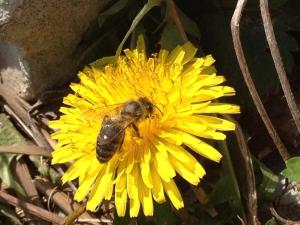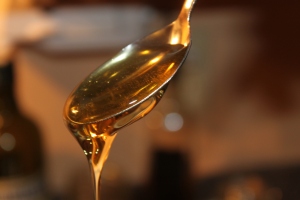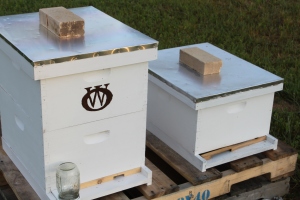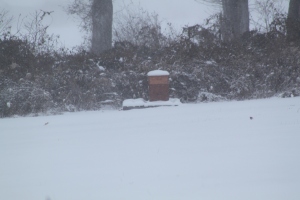Last winter was devastating for honeybee hives in our area – and unfortunately, we were not left unscathed. Our single hive was simply unable to survive the extreme cold of January and February and froze out.

With the absence of food sources through the winter like this dandelion – our honeybees have to rely on the honey they have stored up in the hive.
Contrary to what many people assume, honeybees do not officially hibernate – instead opting to cluster together to form a protective ball around the all important queen. As they cluster, they move and fan their wings about to increase the temperature of the hive and keep the queen safe and warm through normal winter conditions.
This year, we have decided to take a couple of extra steps with our two new hives to help them through the cold winter months.
The Bees Efforts to Prepare for Winter…
The honeybees are the real workers who prepare their own hive for winter – in fact – they are winterizing experts! By now – they have been all around the hive sealing up tiny cracks and holes with propolis – a sticky thick substance they secrete to seal out the winter.
In many ways, it is comparable to the way we fill in cracks and holes around windows and doors with caulking to keep out the elements.
They have also reduced their overwinter population by forcing a large majority of the male bees out into the cold to die. It may sound harsh – but the male bees perform no work related duties in the hive, and are simply not needed through the winter months. (Another reason I make sure I appear busy to Mary all Winter 🙂 )
Our Normal Preparations…
As we do each fall, we insert an entrance reducer into the main hive body to keep out cold drafts and help to deter small mice or varmints that may try to rob the honey stored inside. The small 3/4″ opening still allows the bees to exit if needed – but keeps the opening to the bare minimum – protecting the hive and the bees. Without the presence of blooming flowers – the activity slows to a crawl, so a larger opening is simply not necessary.

We left all of the honey in the bottom sections of each hive for the bees this year to help them through.
In fact, the bees only leave the hive through the winter months when the temperature gets beyond the 50 degree mark, taking what most beekeepers call cleansing flights. These are quick trips used by the bees to clean their hives. Beyond those few warmer days – the bees will stay in that tight cluster awaiting the arrival of spring.
Since this is the first full year for our replacement bees – we left all of the honey on the bottom two sections in place for them to have for winter use. The honey is what they will consume to have the energy for all of that wing flapping and temperature control.
We have also supplemented the stored honey by placing pollen patties inside the hive. They are simply an additional food source that will help them have enough stored food for the winter. This is a practice that we did not perform in the past, but after last year, we want to give our bees every advantage we can!
Additional Protection…
Speaking of additional advantages – this year we are also taking a few extra precautionary steps to help the hive survive mother nature’s wrath.

The hive entrances will be reduced to a single 3/4 inch opening for winter – like the one on the left hive.
First, we are installing a wind block a foot behind the two hives to block the chilling winds that blow through from the west. We will drive in a few stakes in to the ground today and then attach a 4′ plywood sheet to help keep the winds from blowing through.
In addition to the wind block, we will also wrap our hives in 2″ foam and then cover in black plastic help to add an extra layer of insulation to the hives. The black plastic will also help to absorb any of the sun’s winter rays and provide a little extra warm-up to the hive.
Hopefully, our winter is a bit more mild than last year’s 2nd coming of the Ice Age – but if it isn’t – at least our bees will have a better chance of making it through!
Jim and Mary – Old World Garden Farms
If you would like to receive our posts each week on Gardening, Cooking, Canning and a DIY Approach to Living – be sure to sign up to follow the blog via email in the right hand column, “like” us on Facebook, or follow us on Twitter.

